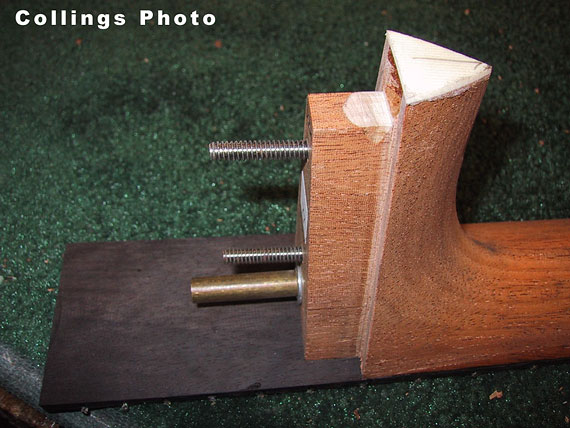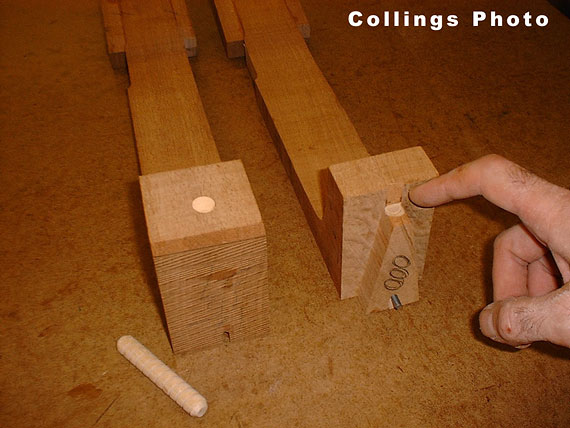
 |
|
#1
|
|||
|
|||
|
Hi All
I am in the process of constructing my first two guitars. I have two parallel projects running to try different design and construction strategies concurrently. I have chosen a mortise and tenon style bolt on joint for the first, but am wondering about trying the tenonless joint that R.M. Mottola describes here for my other experiment I would like to hear from anyone who has effected this style of joint and their opinions as to it's ease of implementation and success over time as compared with other joints they have tried. Trust me when I say I have read around this a little - I have already discounted a traditional dovetail joint in favour of a bolt-on, more easily removable solution so I guess I'm looking for advice from someone who has tried this already. Thanks for reading and for any insight you may offer Matt |
|
#2
|
|||
|
|||
|
Ask yourself, what purpose does the tenon serve in a bolt on m&t? In a dovetail, it's obviously the only way it can work. But in a straight tenon, all it does is hold the inserts. Rare are those who make it so tight that there is wood to wood contact between mortise and tenon. How would you control fine tuning of centerline? And would wood to wood contact make any difference in tone? I don't believe so.
My first 50+ guitars (and the thousands I fit at Larrivee) were dovetails. Then I switched to double m&t for about 10 guitars, but didn't like how quickly they slipped forward without the shear strength from a glued tongue. Then I started the Halcyon line and 'cheaped out' on the neck, and quickly realized it's the most pragmatic, at least for me. So, if one thinks (as I do) that the only thing the tenon in a bolt on m&t does is hold the inserts, it's not much of a stretch to consider it unnecessary. So that's how I feel anyway. No complicated routing jigs required, thanks, just a couple of well drilled holes...  
|
|
#3
|
|||
|
|||
|
Quote:
 
__________________
Cheers, Frank Ford |
|
#4
|
|||
|
|||
|
Fair enough, there's merit in that for sure. One can run a dowel through a heel as well, though you might not be able to make it small and pointy like that Collings. That's the first time I've seen that particular joint, with the dovetail having straight edges like that. Can't say that I see the point, though I can't say I see any reason not to either. I guess it gets would to wood contact all round? Plus they're using hangar bolts, and I can see why you might want to drive them in a little deeper. Though Mario Proulx uses them in a butt joint, I believe...
I use threaded inserts in the heel, with a liberal dash of CA the keep them in. The only way to remove them I've found has been total destruction. I feel very confident in their future stability. Are Taylor's not still a butt joint with inserts? |
|
#5
|
|||
|
|||
|
A surprising number of people call the Collings joint a "straight-sided dovetail," which, of course, it is not.
It's a tapered mortise - one that slides straight in, just as a regular mortise would. It is not glued, but screwed, using the hanger bolts. Threaded inserts would work fine, but Collings kills both birds by reinforcing with the dowel, strengthening the entire heel as well as providing great support for the wood screw section of the bolts. Taylor uses a sort of "inserted" butt joint, where the heel is quite deep, an stuck into a pocket in the neck block. IF you're not familiar with it, here's a quick video from the Taylor site: http://www.taylorguitars.com/media/t...uitars-nt-neck Indeed, I have seen heels broken straight through the inserts, although it usually takes a fair blow to achieve that damage. Your friendly airline baggage handler might be able to oblige a demo. . .
__________________
Cheers, Frank Ford |
|
#6
|
|||
|
|||
|
Quote:
I built a few guitars with bolt-on necks in the late-1980's. I used a method similar to Collings....though I had no Idea what they were using at that time. My straight tenon was 5/8" wide, and I used a 3/8" maple dowel in the heel to screw the single 3/16" hanger bolt into. On mine, the truss rod extended through the neck block, and tightening it helped pull the neck against the body while gluing the fingerboard to the top. On at least one of them, I added a 3/16" by 1" strip of maple to the face of the neck block to reinforce the block. BTW, the use of 1/4" bolts by Taylor and Martin is way overkill, IMHO. 3/16" is plenty strong enough, and not so heavy. Quote:
|
|
#7
|
|||
|
|||
|
FWIW to OP, the bolt on butt joint seems to be working fine for me. No pullouts (the only way to salvage them once they're in is to destroy the neck around it), and no cracked heels in the insert area. I don't (and don't believe one can) build to defend against the airlines. One can do only so much. YMMV...

|
|
#8
|
|||
|
|||
|
Yep, more than strong enuf. The Collings hangers are #10, roughly 3/16," and coincidentally, the same size as the hanger bolts that have served to mount Gibson Mastertone banjo necks for the last 90 years. . .
__________________
Cheers, Frank Ford |
|
#9
|
|||
|
|||
|
Quote:
|
|
#10
|
|||
|
|||
|
It was the Bourgiouse (I can never remember the spelling) / Maize joint.
I believe they were slipping forward because there was not enough shear strength in the tongue connection, which I think really helps. I was going to examine modifications, and I believe current users of said joint have done mods in that regard. Your joint makes much sense to me, but on a 1299 guitar it seems an awful lot of extra steps. I just glue the very perimeter of the tongue only with a 1/16" bead just to keep it tacked down, which should in theory be very easy to undo. So far they have proved very stable. And if not, very easy to rectify... That being said, I would like to experiment with a more advanced design such as yours, but there are so many more pressing concerns that demand attention presently... |
|
#11
|
|||
|
|||
|
Quote:
|
|
#12
|
|||
|
|||
|
Thanks, Ed. Yes, that joint might be susceptible to hinging at the body joint fret if the screws don't hold the shear.
|
|
#13
|
|||
|
|||
|
Bourgeois/Mayes...no offence intended to either.
Can't believe I got 'em both wrong. Long day... Anyway, yeah, that's exactly what happened. They hinged forward in the settling in period. Being bolt ons, it's a ten minute or less fix, but sometimes people don't even notice, as it happens so gradually. They only notice the big change for the better when it gets put back right. |
|
#14
|
|||
|
|||
|
Thanks for all your replies. I have now completed one of each kind. That first photo is pretty much exactly what I have done for my tenonless joint. The tenon joint I have made also uses the same threaded inserts. The process is MUCH simpler without the tenon and I think also less invasive down the line when the neck needs resetting.
I note the use of brass threaded inserts - any reason for that preference? Anyway, nice to have the affirmation. Cheers Matt |
|
#15
|
|||
|
|||
|
Similar butt joint here. I take it a small step further by inserting a 3/8" maple dowel to hold the threads. Takes a heckuva lot of tension to pull an insert out of the dowel.
The joint provides so much flexibility, not to mention 20 minute neck resets. As I see my preferences in style and sound forming, Martin has been a huge influence, Bruce Sexauer almost as much, but I need a better reason than tradition to use a different neck joint than the butt jooint. Pondering a switch to carriage bolts, though... |
 |
|
| Tags |
| neck joint bolt mottola |
|
|